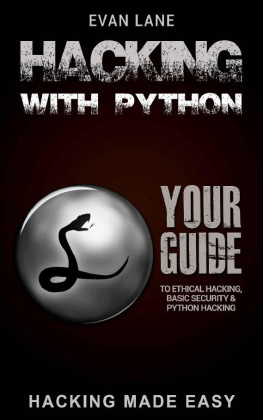Najim Developer - For Beginners Guide Hacking On How To Hack, Computer Books New
Here you can read online Najim Developer - For Beginners Guide Hacking On How To Hack, Computer Books New full text of the book (entire story) in english for free. Download pdf and epub, get meaning, cover and reviews about this ebook. year: 2017, genre: Computer. Description of the work, (preface) as well as reviews are available. Best literature library LitArk.com created for fans of good reading and offers a wide selection of genres:
Romance novel
Science fiction
Adventure
Detective
Science
History
Home and family
Prose
Art
Politics
Computer
Non-fiction
Religion
Business
Children
Humor
Choose a favorite category and find really read worthwhile books. Enjoy immersion in the world of imagination, feel the emotions of the characters or learn something new for yourself, make an fascinating discovery.
- Book:For Beginners Guide Hacking On How To Hack, Computer Books New
- Author:
- Genre:
- Year:2017
- Rating:3 / 5
- Favourites:Add to favourites
- Your mark:
- 60
- 1
- 2
- 3
- 4
- 5
For Beginners Guide Hacking On How To Hack, Computer Books New: summary, description and annotation
We offer to read an annotation, description, summary or preface (depends on what the author of the book "For Beginners Guide Hacking On How To Hack, Computer Books New" wrote himself). If you haven't found the necessary information about the book — write in the comments, we will try to find it.
For Beginners Guide Hacking On How To Hack, Computer Books New — read online for free the complete book (whole text) full work
Below is the text of the book, divided by pages. System saving the place of the last page read, allows you to conveniently read the book "For Beginners Guide Hacking On How To Hack, Computer Books New" online for free, without having to search again every time where you left off. Put a bookmark, and you can go to the page where you finished reading at any time.
Font size:
Interval:
Bookmark:
Copyright 2017 For Beginners Guide Hacking On How To Hack, Computer Books New
All rights reserved. No part of this work may be reproduced or transmitted in any form or by any means, electronic or
mechanical, including photocopying, recording, or by any information storage or retrieval system, without the prior
written permission of the copyright owner and the publisher.For Beginners Guide Hacking On How To Hack, Computer Books New
The following topics are discussed in this book
Computer Hacking------------------------------1
Hacking and Security---------------------------2
Software Security------------------------3
Network Security-------------------------4
Programming Languages ----------------------5
enetration Testing--------------------------------6
They may demonstrate some of the same signature characteristics as malware and malicious implants, and may raise antivirus alerts when you try to download them. Again, we can't provide assurance that the software hasn't been compromised when you download it, and so as for any other software from the internet, you need to exercise due diligence and take personal responsibility for anything you load into your system. The testing is mostly carried out inside a virtual environment to contain any unplanned effects of testing tools. And in the unlikely event that you do download malware, this will also help contain any impact from live malware.
'll discuss what you should test in your organization, such as physical and wireless security, and ask hard questions, such as: "Can our website be hacked?", and "Is your company leaking data "via email or voiceover IP?" This course is part of the Ethical Hacking series. Are you ready? Let's get started.
Auditing is ensuring something is as it should be. For example, if the bowling club checkbook is to have a 92 dollar balance, auditing assures that when I check the balance, it is, indeed, 92 dollars. On a network, a security audit is a comprehensive assessment of the safety of a company's information assets. Auditing, generally, follows a structured plan, or set of criteria, such as PCI compliance. Auditing a network can be a complex undertaking.
Today's networks have many attack surfaces, or areas of exposure. Attack surfaces can include software, hardware, network, and users. Auditing the attack surface identifies potential vulnerabilities. Auditing can be done voluntarily, but in most cases, auditing is required as part of a compliance regulation. When faced with an audit, managers fear what weaknesses they might find .
A software assessment might include the system software, such as the directory, logging used, and authentication protocols used for network services such as DNS Security. And application software, specifically web and mobile platform testing, and a network assessment. We check the devices such as firewalls, intrusion detection systems, intrusion prevention, and logging and alert capabilities, along with configuration and authentication methods and visible network services, and check the users.
Using social engineering techniques, we see if we can gain access into the building. Such as, tailgating or piggybacking, and phishing attacks using email, instant messaging, and social media to get employees to click on a link to release malware or download a rootkit. Auditing, generally, follows a predefined plan. Reconnaissance, scanning, gaining access, and exploitation. Before, actually, launching any attacks or using advanced tools, the penetration tester must complete a thorough information gathering exercise and obtain as much information about the target as possible, to see what is visible to a would-be attacker.
This is time consuming. It could, possibly, take weeks to complete. However, to save some time, some information can be provided, such as, IP address ranges or user names and passwords. After footprinting and reconnaissance, scanning is the second phase, of information gathering, that hackers use to size up a network. Scanning is where they dive deeper into the system and look for valuable data and services in a specific IP address range.
Auditing is not a spot check. It's a complete evaluation of a security posture of an organization. In today's organizations, everyone is responsible for the security of an organization. Instead of waiting to be compelled to have an audit, or worse yet, finding you have weaknesses by being the victim of a hack, an organization should, proactively, go through annual audits.
In general, a threat is difficult to control. A vulnerability is a security flaw in a system that a threat can exploit in order to gain unauthorized access to an asset. Connecting a system to the internet can represent a vulnerability if the system is unpatched. Vulnerabilities include human error or software flaws. Vulnerabilities are things we can fix. A risk is an exposure to an event by a person or other entity that can result in business disruption, financial loss, or even loss of life, and is a function of a threat exploiting a vulnerability according to a formula.
Risk equals threat times vulnerability. In order to understand the overall risk to the company's assets, we must evaluate possible threats and locate the vulnerabilities. All operating systems and application software have vulnerabilities. Various reputable vulnerability scanners are available to the analyst. The analyst checks the operating systems and applications against a database of reported vulnerabilities.
An authenticated scan is a much more powerful scan, mainly because a valid username and password is used with the objective to mimic a user in the system or website. The analyst should use several tools and scanners to compare different environments. The tool will display the results. A security analyst conducting an audit does more then run a scan, he or she will interpret the results and assess a priority.
Whether or not the system vulnerability will be tested will be up to the organization. The fact is, running an exploit may bring the system down, so use caution. We identify vulnerabilities with the ultimate goal to determine if someone can attack the system. Stay up to date on patches to reduce the risk of an attack.
If you're in charge of protecting the digital assets, the only way you'll know how your system will perform under an attack is by simulating attacks under controlled circumstances instead of waiting for a real breach to occur and face the consequences. Penetration testing or ethical hacking is a proactive security assessment that tests internal and external systems by simulating attacks. During testing, security specialists review policies and procedures of an information system with the goal of reducing overall risks.
Regardless, a complete assessment will pay off in many ways. The obvious is discovering your weaknesses and answer questions such as do we have any unnecessary services running? Are social engineering techniques effective? What are the exploitable vulnerabilities? Are anti-malware signatures up to date? And are the operating system patches current? The penetration test is a simulated attack and that the systems will face the same scrutiny that would be evident during a real attack.
There are a couple of main differences. The ethical hacker has written permission. In some cases, they have the username and passwords of a user-level account with the goal to see if they can elevate the status to super-user and they know when to stop and notify someone when they find a major vulnerability. Once an assessment of the overall posture is complete, the analysts identify deficiencies and recommend changes with the goal of improving overall security.
A black box test will simulate how far a hacker can get into the system with no knowledge about the system, usernames or passwords, or even network configuration. The theory is that this would be exactly the type of attack that an organization would face and will give a more accurate indication of the potential threats to your network. The advantage to black box testing is the ability to see how effective the access controls and defenses are against a determined hacker trying to gain access into your network from the outside.
Next pageFont size:
Interval:
Bookmark:
Similar books «For Beginners Guide Hacking On How To Hack, Computer Books New»
Look at similar books to For Beginners Guide Hacking On How To Hack, Computer Books New. We have selected literature similar in name and meaning in the hope of providing readers with more options to find new, interesting, not yet read works.
Discussion, reviews of the book For Beginners Guide Hacking On How To Hack, Computer Books New and just readers' own opinions. Leave your comments, write what you think about the work, its meaning or the main characters. Specify what exactly you liked and what you didn't like, and why you think so.










